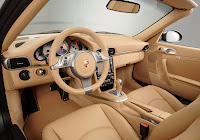Dodge Viper SRT10, 2008
The new 2008 Dodge Viper SRT10 boasts more of what performance aficionados crave: kick-in-the-pants, throw-back-in-the-seat power, combined with benchmark braking, world-class ride and handling, a race-inspired interior and bold exterior styling.
Standout Powertrain
When SRT powertrain engineers set out to get more venom from the 2008 Dodge Viper SRT10's powerplant, their objectives included not only increasing performance, but also complying with stringent regulatory requirements, such as federal Tier 2, Bin 5 and California's Low Emissions Vehicle (LEV) 2 mandates.
Working with specialists from McLaren Performance Technologies and Ricardo, Inc., SRT engineers began by following the racer's basic formula for more power: bigger displacement, more efficient breathing and higher engine speed.
The new Dodge Viper SRT10's deep-skirted V-10 aluminum engine block was revised for a 1-millimeter larger bore, raising the displacement to 8.4 liters from 8.3 liters. With strengthened bulkheads and improved water jackets for better cooling, the block includes pressed-in iron cylinder liners and cross-bolted main bearing caps for strength and durability.
The Viper SRT10's 8.4-liter engine breathes through new cylinder heads equipped with Computer Numerically Controlled (CNC)-shaped combustion chambers, larger valves and Variable Valve Timing (VVT). VVT electronically adjusts when the exhaust valves are open and closed according to engine speed and load, allowing the engine to "breathe" cleaner and more efficiently.
The 2008 Dodge Viper SRT10 V-10's two-piece intake manifold combines a cast aluminum lower with smooth runners for better air flow, bolted to a die-cast aluminum upper plenum. A revised air-cleaner box with a low-restriction filter sends air through a dual electronic throttle control into the intake module.
The air-fuel mixture in the cylinders is ignited by platinum-tip spark plugs fired by new individual plug coils mounted on the cylinder-head covers.
Within the cylinders, pistons are equipped with larger-diameter floating pins with bronze bushings for high-load capability. Forged powder-metal connecting rods are secured with aircraft-quality fasteners for increased fatigue strength.
Engine lubrication is managed by a larger oil pump and a swinging oil pickup adapted from Viper competition engines, to improve oil pressure in high-rpm and hard-cornering conditions.
Spent gases exit through tubular air-gap headers, which not only improve exhaust flow, but also ensure quick catalyst light-off for improved emission control. The headers' stamped stainless-steel outer shell acts as a thermal heat shield for the individual stainless-steel runners that contribute to better flow separation and exhaust tuning.
SRT engineers didn't stop there. Upgrades were developed to handle the 8.4-liter V-10's increased horsepower and torque levels, while improving traction, driveability - and durability.
The 2008 Dodge Viper SRT10's V-10 channels its power through a new, smaller-diameter, twin-disc clutch (a change from the previous larger-diameter, single-disc setup). The new clutch reduces rotating inertia by 18 percent, resulting in reduced clutch-pedal effort and improved engagement feel.
The transmission is the latest evolution of the Tremec T56 six-speed manual, known as the TR6060. It features 10 percent wider gears for higher torque capacity and a new synchronizer package. A new shifter system results in reduced shifter travel. Club racers will applaud a new provision for adding an external transmission cooler.
Benchmark Braking
Stopping power is another key attribute of the Dodge Viper SRT10 formula, with 14-inch brake rotors gripped by Brembo 44/40 dual opposing piston calipers in the front and Brembo 42/38 dual opposing calipers in the rear. An anti-lock braking system (ABS) prevents lockup during hard braking. This system results in a benchmark braking performance of 60-to-0 mph in less than 100 feet.
World-class Ride and Handling
The ride and handling of the 2008 Dodge Viper SRT10 is defined by a race-bred, fully independent, four-wheel suspension featuring lightweight, high-performance aluminum control arms and knuckles, damped by lightweight coil-over shock absorbers.
Where the power goes right to the road, SRT engineers retained the tried-and-true Dana M44-4 rear axle and outfitted it with a new GKN Visco-Lok speed-sensing limited-slip differential for improved traction.
Bold Exterior Styling
The 2008 Dodge Viper SRT10 remains available in two body styles - Roadster and Coupe. Both feature a dramatic new hood with a larger, more efficient hood scoop for air induction and larger, functional hood louvers to facilitate a greater cooling effect for the more powerful 8.4-liter, 600-horsepower V-10 engine underneath.
Eight exterior colors will be introduced throughout the model year - five of which are all-new including Venom Red, Snakeskin Green, Viper Violet, Viper Orange and Bright Blue. Racing stripes continue to be an option with six dual painted stripe colors available: white, black, silver, graphite, blue and red.
The Dodge Viper SRT10 Coupe's hard top with its "double bubble" styling makes it even more torsionally stiff than the Roadster. The 2008 Dodge Viper SRT10 Coupe offers increased downforce and high-speed stability with its sloping roofline and deck-lid spoiler. Plus, the Dodge Viper SRT10 Coupe has an additional 6.25 cubic feet of trunk space than the Viper SRT10 Roadster, for a total of 14.65 cubic feet. The roof and headliner structure offer more room to accommodate a safety cage, while maintaining as much headroom as possible.
Race-inspired Interior Design
The 2008 Dodge Viper SRT10 Roadster and Coupe cockpit retains its characteristic red push-button starter and performance-oriented, highly functional instrument panel with center-mounted tachometer and 220-mph speedometer.
Five interior colors will be available in 2008: black, and four new color combinations in black/red, black/blue, black/slate or black/natural tan. A choice of bezel finishes on the center instrument panel and console adds to the increased level of customization.


















































